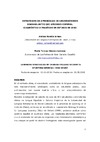Please use this identifier to cite or link to this item:
https://accedacris.ulpgc.es/jspui/handle/10553/70229
| Title: | Estrategias de aprendizaje de universitarios sinohablantes que aprenden español: diagnóstico a través de un estudio de caso | Other Titles: | Learning strategies of chinese college students studying spanish: case study | Authors: | Ramón Armas, Ainhoa Cáceres Lorenzo, M. Teresa |
UNESCO Clasification: | 5701 Lingüística aplicada 570111 Enseñanza de lenguas |
Keywords: | Español como lengua extranjera Estudiante sinohablante universitario Estrategias de aprendizaje Strategy Inventory for Language Learning (SILL) Estudio de caso, et al |
Issue Date: | 2019 | Journal: | Tonos Digital | Abstract: | En el contexto chino, el aprendiente sinohablante de lenguas extranjeras ha sido tradicionalmente catalogado como un estudiante pasivo, poco participativo, con escaso espíritu crítico y con preponderancia de aprendizaje memorístico. Nuestra investigación de estudio de caso de 403 estudiantes universitarios chinos de Lengua Española y Cultura Hispánica de la Universidad de Lenguas Extranjeras de Dalian (ubicada en la provincia de Liaoning en el norte de China), en la que se ha utilizado el cuestionario Strategy Inventory for Language Learning (SILL) de Oxford (1990); pretende analizar cómo aprende español el alumnado chino. Los resultados obtenidos, confirman que el alumnado encuestado no responde a los mencionados estereotipos y nos dibujan un perfil de alumno homogéneo. Esta investigación quiere ser un diagnóstico del aprendiz chino a través de un estudio de casos que contribuya en el proceso de enseñanza/aprendizaje de ELE. In the Chinese context, the Chinese foreign language learner has traditionally been classified as a passive student, not actively participating, with a low critical spirit and a tendency to memorize by rote. Our case study research of 403 Chinese college students studying a degree in Spanish language and Hispanic Culture at Dallan Foreign Language University (Liaoning Province, northern China) aims to analyze how Chinese students learn Spanish using the questionnaire 'Strategy Inventory for Language Learning' (SILL; Oxford, 1990). The results obtained confirm that the surveyed students do not respond to the aforementioned stereotypes and instead draw us a fairly homogeneous student profile. The research aims to offer an analysis of the Chinese learner through a case study that contributes to the teaching/learning process of ELE. |
URI: | https://accedacris.ulpgc.es/handle/10553/70229 | ISSN: | 1577-6921 | Source: | Tonos digital: revista de estudios fiflológicos [ISSN 1577-6921], n. 37 |
| Appears in Collections: | Artículos |
Page view(s)
309
checked on Mar 9, 2024
Download(s)
214
checked on Mar 9, 2024
Google ScholarTM
Check
Share
Export metadata
Items in accedaCRIS are protected by copyright, with all rights reserved, unless otherwise indicated.
